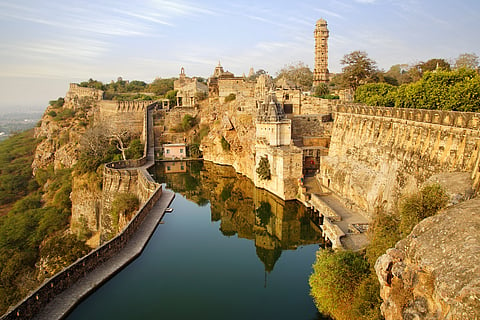
- Destinations
- Experiences
- Stay
- What's new
- Celebrating People
- Responsible Tourism
- CampaignsCampaigns
- SubscribeSubscribe
- Buy Now

A major stronghold of the Rajputs, Chittorgarh is home to the majestic Chittorgarh Fort, reminiscent of the Rajputana sacrifice, pride, and loyalty. One of the largest forts in India, it is renowned for its architectural brilliance and historical relevance, where whispers of Rajput warriors and legends of sacrifice still linger. Brace yourself as we journey through this iconic landmark's magnificent palaces, gory battlegrounds, and stunning views.
Declared a UNESCO world heritage site under the Hill Forts of Rajasthan, Chittorgarh Fort is a colossal monument spread across 700 acres with a 13 km-long perimeter wall. The fort has always been the pride of the Rajput Kings.
Originally called Chitrakuta, legend has it that the fort was built around 728 CE by the Mauryan king, Chitranga. History, however, credits the mighty Guhila king, Bappa Rawal, from the 8th century. Between the 8th and 16th centuries, descendants of Bappa Rawal ruled the city and the fort.
In 1303, Allauddin Khilji, Sultan of Delhi, set sights on the fort's riches and was intrigued by Queen Padmini's beauty. The siege lasted eight months, a testament to the Rajputs' resilience. But ultimately, through treachery, the fort fell. Legend has it that to avoid dishonour, Rajput women performed Jauhar, a ritual of self-immolation before Khilji's army entered the fort.
Chittorgarh rose again, only to face further challenges. Bahadur Shah of Gujarat captured it in 1535, leading to another Jauhar. Finally, in 1568, the Mughal emperor Akbar laid siege. After a valiant defence, the fort fell once more.
Yet, Chittorgarh's spirit remained unbroken. It served as a rallying point for the Rajputs, symbolising their unwavering defiance. Today, the fort stands as a magnificent testament to a glorious past.
Chittorgarh Fort isn't just a historical monument; it is a testament to the architectural prowess of Rajputana kings. It boasts a network of palaces, temples, and cenotaphs, each whispering tales of a bygone era.
Within the fort's embrace lies the Rana Kumbha Palace, built in the 15th century. It reflects the Rajput style with ornately carved pillars, jharokha windows, and pillared balconies. Another archaeological gem is the Fateh Prakash Palace, constructed in the 19th century, with hints of European flamboyance. The intricately carved Kirti Stambh (Tower of Fame) stands nine stories tall, commemorating Rana Kumbha's victories. Though partially ruined, the Padmini Palace retains its ethereal beauty, and its legend adds to its mystique. The fort has many religious structures, too. Dotted throughout are numerous temples, each with a distinct architectural style reflecting the region's diverse religious heritage.
The Chittorgarh Fort was not only about aesthetics and defence. The architects made an elaborate network of underground tanks and wells, ensuring a steady water supply even during prolonged sieges. There were 84 water bodies within the fort, and today, 22 of them still exist.
Chittorgarh Fort is the city's crown jewel, with thousands of tourists flocking here to see the grandeur of this historic monument and listen to the tales of bravery and sacrifice. But Chittorgarh has more to offer tourists. If you have the time, visit the vibrant bazaars of this town. You can buy colourful textiles and handicrafts as a memoir. Savour a traditional Rajasthani meal of Dal Baati Churma, Gatte ki Sabzi, and Lal Maas.
For wildlife enthusiasts, a trip to Sitamata Wildlife Sanctuary and Bhainsrodgarh Wildlife Sanctuary is a must. Located about 30 km from Chittorgarh, they are home to many animals, including leopards, wild boars, hyenas, and chinkaras.
Chittorgarh isn't just a fort; it's an experience. The best way to explore its gems is to hire a local guide.
Getting There
By air: The nearest airport is Udaipur, located 95 km from Chittorgarh
By train: Chittorgarh railway station is connected to most of the major cities of Rajasthan, including Kota, Jodhpur, Jaipur, Bhilwara, and Udaipur. There are weekly trains from Kolkata, Pune, Mumbai, Kanpur, Hyderabad, Bangalore, and Agra.
By road: To enjoy the scenic beauty of Rajasthan, you can drive from Jaipur to Chittorgarh, which takes approximately 6 hours.
Best Time To Visit
Between October and March
Entry Tickets
For Indians: INR 50 for adults and INR 35 for children
For Non-Indians: INR 200
Sound and Light Show: INR 150 for adults and INR 75 for students/children. For foreign tourists, the price is INR 300 (adults) and INR 150 (children).
Timings
10 am to 5 pm. It takes about 3-4 hours to see the fort.
